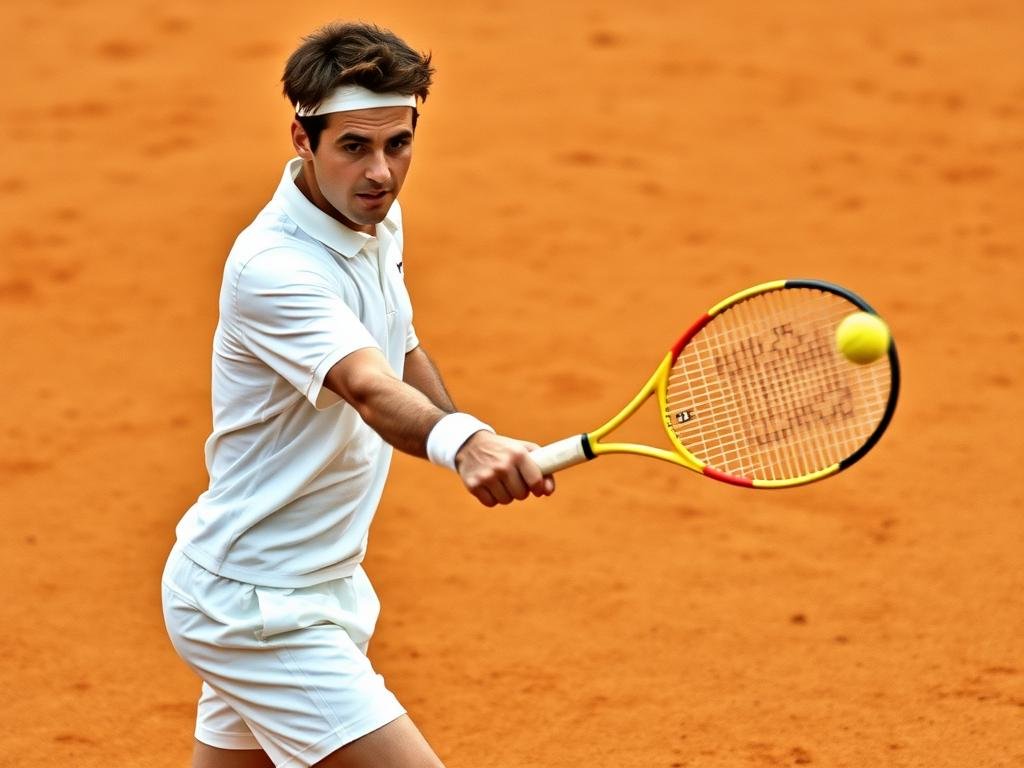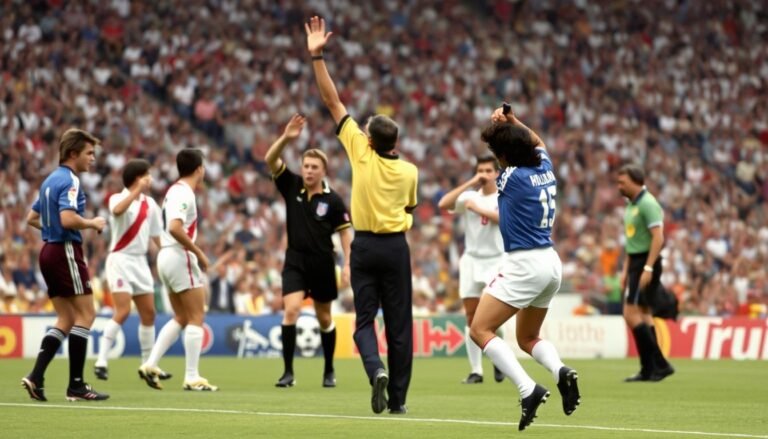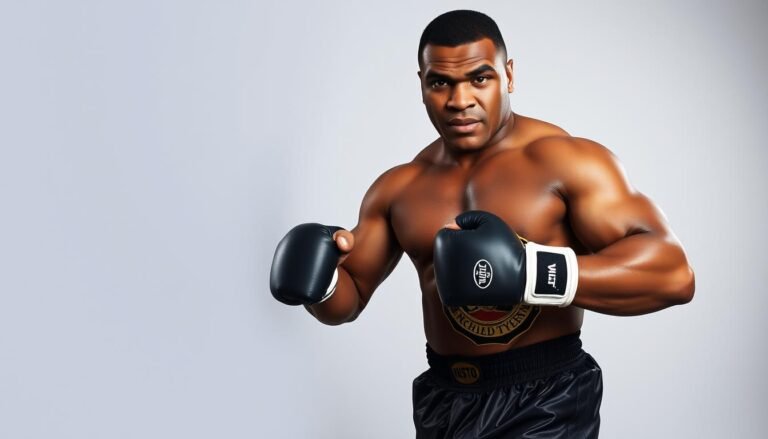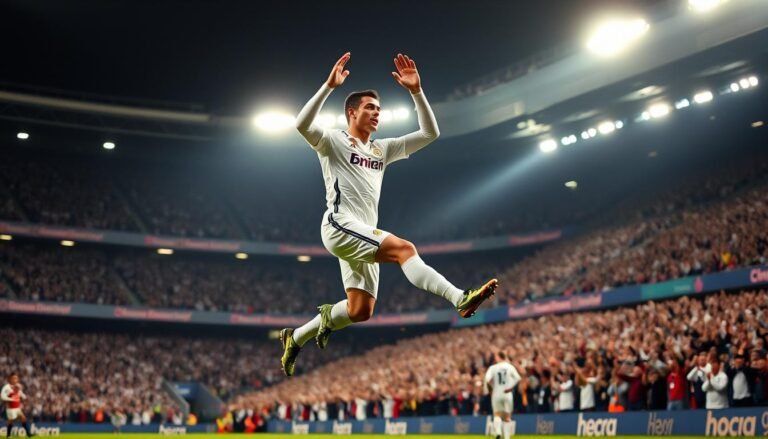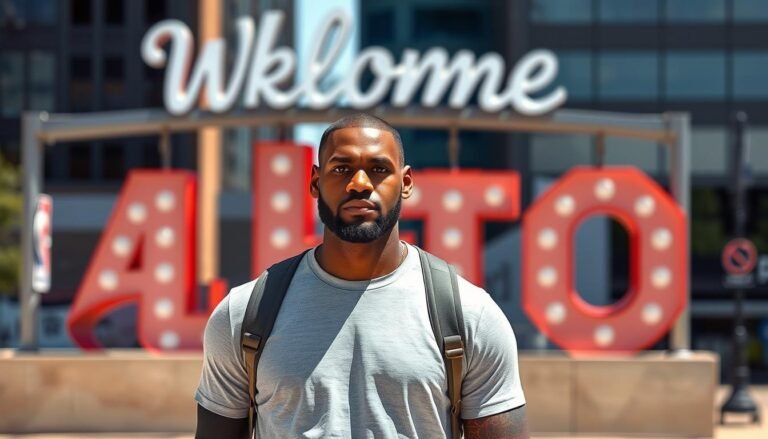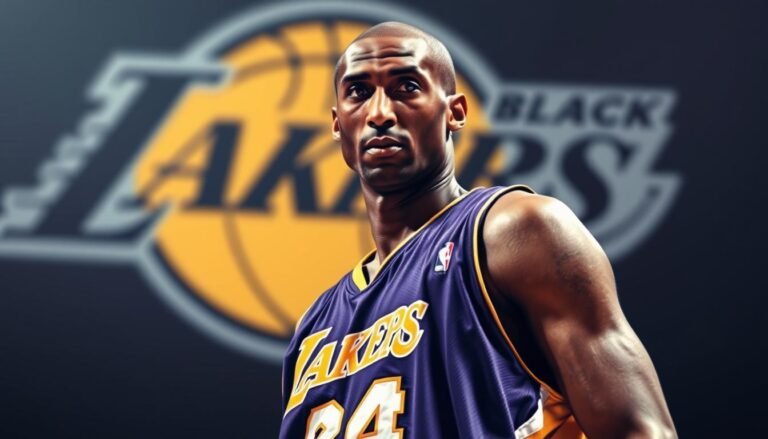Roger Federer – The Graceful King
Few athletes have transcended their sport quite like Roger Federer. The Swiss maestro’s two-decade reign at tennis’s pinnacle wasn’t merely about accumulating trophies and records—though he amassed plenty. It was about redefining what athletic excellence could look like: graceful yet powerful, technical yet intuitive, competitive yet sportsmanlike. As we explore Federer’s remarkable journey from a temperamental junior player to a global icon, we discover how one man’s pursuit of perfection elevated an entire sport and left an indelible mark on sporting culture worldwide.
The Making of a Champion
Born on August 8, 1981, in Basel, Switzerland, Roger Federer’s journey to tennis royalty began with humble origins. The son of Robert and Lynette Federer, young Roger first picked up a racquet at age three, spending weekends at his parents’ workplace tennis courts. His natural coordination—honed through playing multiple sports including badminton, basketball, and football—laid the foundation for his future athletic prowess.
What many don’t realize is that the composed champion we came to know was once a temperamental youth. As a teenager, Federer struggled with emotional outbursts on court, often throwing his racquet in frustration when shots didn’t meet his exacting standards. This early struggle with composure makes his later reputation for grace under pressure all the more remarkable.
His talent was undeniable, however. By age 14, Federer was training at Switzerland’s National Tennis Center, and in 1998, he captured both the Wimbledon junior singles and doubles titles. This early success foreshadowed the unprecedented dominance he would later establish on the hallowed grass courts of the All England Club.
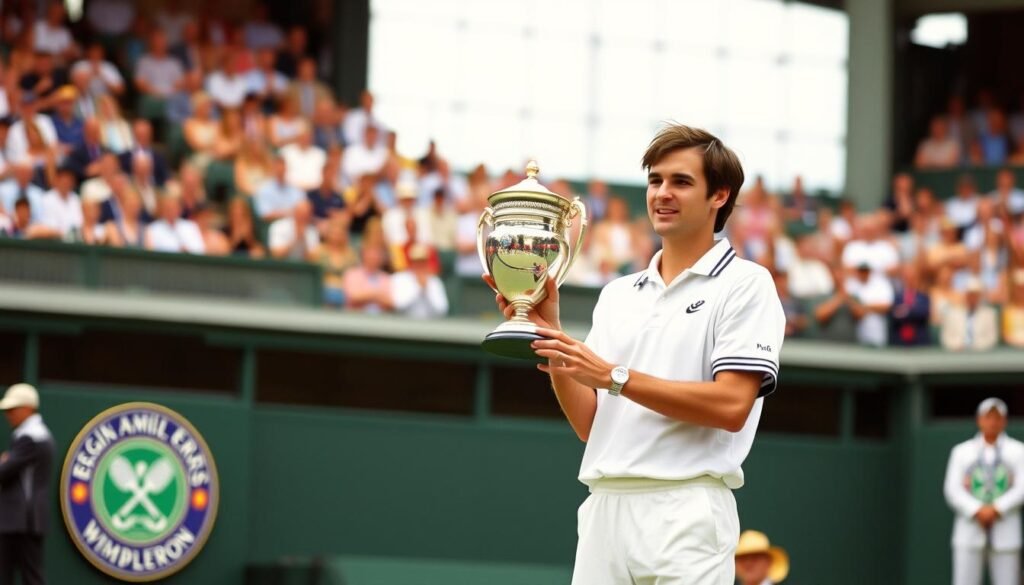
The transition to professional tennis brought challenges. Federer’s early professional years were marked by inconsistency—flashes of brilliance interspersed with disappointing losses. The turning point came in 2001 when he defeated seven-time champion Pete Sampras at Wimbledon in a match many consider the symbolic passing of the torch. Though Federer wouldn’t win that tournament, the victory announced his arrival as a serious contender.
The tragic death of his first coach, Peter Carter, in 2002 profoundly affected Federer. By his own admission, this loss helped transform him from a talented but unfocused player into a dedicated professional determined to maximize his potential. The following year, he would claim his first Grand Slam title at Wimbledon, beginning one of the most remarkable runs in tennis history.
Grand Slam Dominance: Rewriting the Record Books
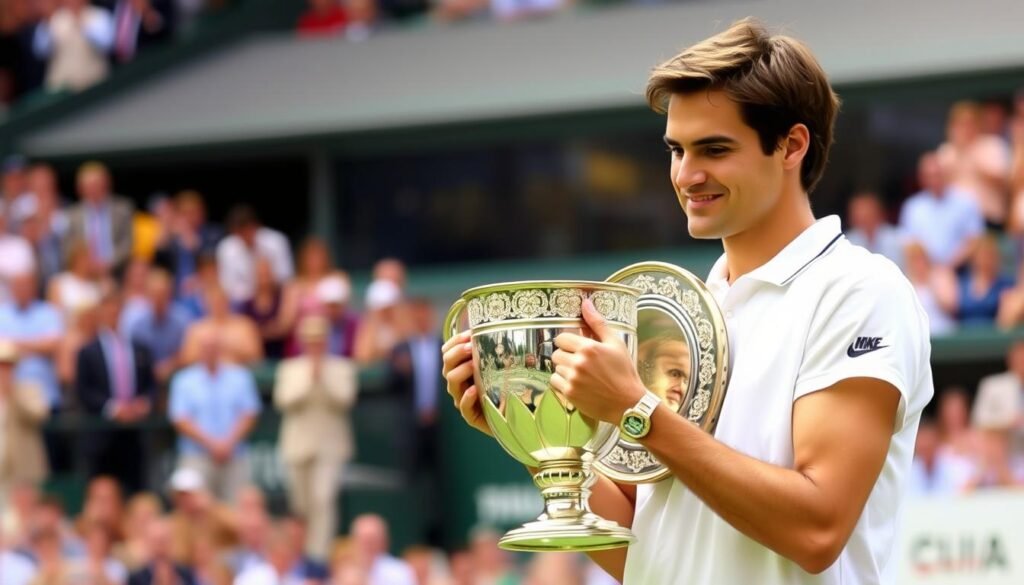
When Roger Federer defeated Mark Philippoussis to win his first Grand Slam at Wimbledon in 2003, few could have predicted the unprecedented era of dominance that would follow. This victory marked the beginning of Federer’s ascent to tennis royalty, as he went on to win an astounding 20 Grand Slam titles over his career.
The period from 2004 to 2007 represented perhaps the most dominant stretch of tennis ever played by a single athlete. During this remarkable run, Federer won 11 of 16 Grand Slam tournaments, including three majors in a single year three times (2004, 2006, and 2007). He reached an astonishing 10 consecutive Grand Slam finals from 2005 to 2007, a record that speaks to his remarkable consistency at the highest level.
| Tournament | Titles | Years | Finals |
| Wimbledon | 8 | 2003, 2004, 2005, 2006, 2007, 2009, 2012, 2017 | 12 |
| Australian Open | 6 | 2004, 2006, 2007, 2010, 2017, 2018 | 7 |
| US Open | 5 | 2004, 2005, 2006, 2007, 2008 | 7 |
| French Open | 1 | 2009 | 5 |
Wimbledon became Federer’s kingdom, where he won a record eight men’s singles titles. His five consecutive Wimbledon victories (2003-2007) tied Björn Borg’s Open Era record. The grass courts perfectly complemented his attacking style, allowing his precise serving, aggressive forehand, and deft volleys to shine.
The 2009 French Open victory proved particularly significant, as it completed Federer’s Career Grand Slam—winning all four major tournaments. This achievement placed him in the rarefied company of tennis legends like Rod Laver, Andre Agassi, and Rafael Nadal. More importantly, it silenced critics who questioned whether he could conquer the challenging clay courts of Roland Garros.
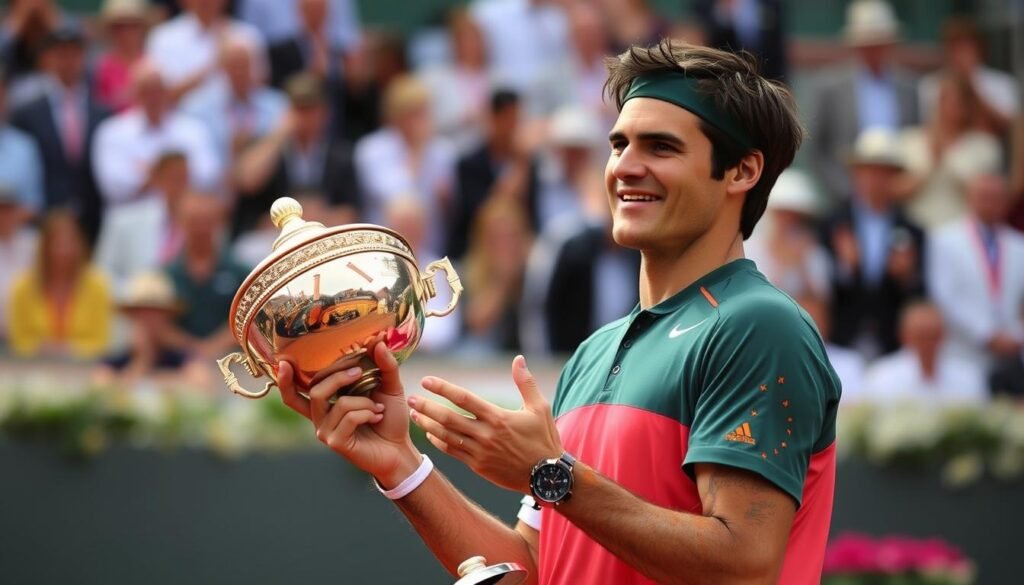
Perhaps most impressive was Federer’s longevity at the top level. After a period where many thought his best days were behind him, he staged a remarkable comeback in 2017, winning the Australian Open and Wimbledon at age 35 after a six-month injury layoff. His final Grand Slam triumph came at the 2018 Australian Open, where he became the first man to win 20 major singles titles.
Beyond the raw numbers, Federer’s Grand Slam performances were characterized by his ability to raise his level in the most crucial moments. His mental fortitude, tactical acumen, and physical conditioning allowed him to maintain his excellence across different surfaces and against evolving generations of challengers.
“When you do something best in life, you don’t really want to give that up – and for me it’s tennis.”
The Federer Aesthetic: Redefining Tennis Elegance
What separated Roger Federer from his contemporaries wasn’t just what he achieved but how he achieved it. His playing style transcended the utilitarian aspects of tennis to create something that many observers, from casual fans to seasoned critics, described as art. The term “elegant playstyle” could have been invented specifically for Federer’s approach to the game.
At the core of Federer’s technique was a remarkable fluidity of movement. Where other players appeared to be exerting maximum effort, Federer seemed to glide across the court with minimal exertion. This economy of movement wasn’t just aesthetically pleasing—it was tactically advantageous, allowing him to conserve energy and maintain peak performance deep into matches.
Technical Mastery
Federer’s technical arsenal was unmatched in its versatility. His serve, while not the fastest on tour, was precisely placed and disguised, making it one of the most effective weapons in the game. His forehand—often described as the greatest shot in tennis history—combined devastating power with pinpoint accuracy.
Perhaps most iconic was his single-handed backhand, a stroke that became increasingly rare in the modern game. While sometimes targeted as a weakness by opponents like Rafael Nadal, Federer’s backhand was capable of both reliable defense and spectacular winners, particularly his inside-out backhand down the line.
Tactical Intelligence
Beyond his technical brilliance, Federer possessed an exceptional tennis IQ. He could seamlessly transition between aggressive baseline play, serve-and-volley tactics, and defensive counterpunching as situations demanded. This adaptability made him effective across all surfaces and against diverse playing styles.
Federer’s anticipation bordered on prescient. He often appeared to know where his opponent would hit the ball before they did, allowing him to take up optimal court positioning. This spatial awareness, combined with his shot-making ability, created the impression that he was playing a different game than his competitors.
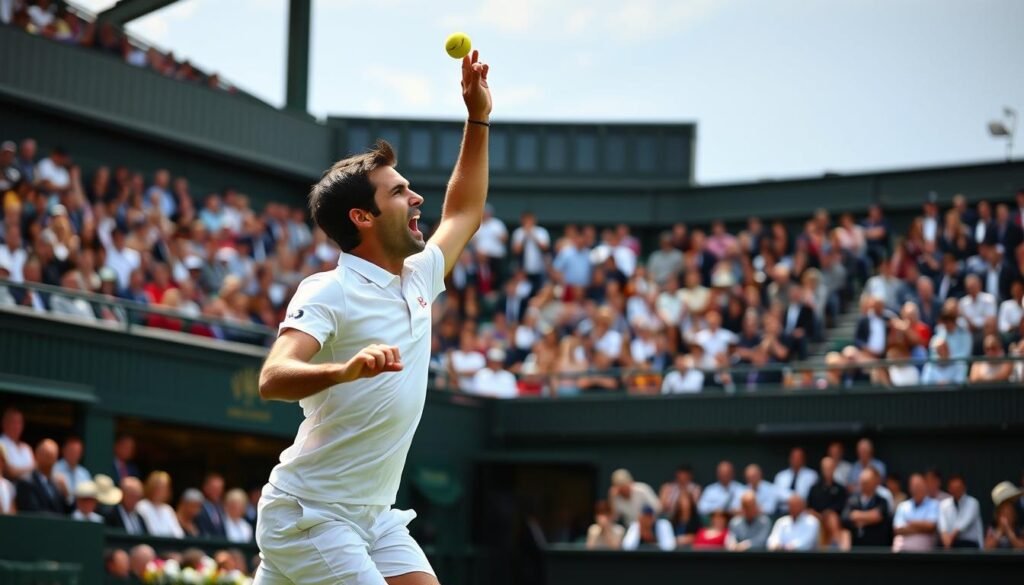
The “Federer Express” nickname aptly captured the Swiss maestro’s ability to efficiently dismantle opponents, often making challenging matches look routine. Yet it was the “Swiss Maestro” moniker that perhaps best encapsulated his artistic approach to tennis. Like a conductor orchestrating a symphony, Federer controlled the rhythm and flow of matches, creating moments of breathtaking beauty amid the intense competition.
Tennis writer David Foster Wallace famously described watching Federer as a “religious experience,” noting that certain moments in his matches could bring spectators to a state of reverential awe. This sentiment was echoed by countless fans who found themselves gasping at seemingly impossible shots that Federer executed with apparent ease.
“Federer’s forehand is a great liquid whip, his backhand a one-hander that he can drive flat, load with topspin, or slice… His serve has world-class pace and a degree of placement and variety no one else comes close to.”
What made Federer’s style particularly remarkable was its effectiveness across eras. As tennis evolved toward a more physical, baseline-oriented game, Federer adapted while maintaining his distinctive approach. He incorporated new elements—like his “SABR” (Sneak Attack By Roger) return—without compromising his fundamental elegance.
The aesthetic quality of Federer’s game wasn’t merely incidental to his success—it was integral to it. His fluid technique reduced strain on his body, contributing to his longevity. His varied shot selection kept opponents off-balance and prevented them from settling into rhythms. His calm demeanor preserved mental energy for crucial moments.
In redefining tennis elegance, Federer demonstrated that beauty and effectiveness need not be mutually exclusive. His legacy includes not just what he accomplished but how he accomplished it: with a grace that elevated tennis from sport to art.
The Significance of “The Graceful King”
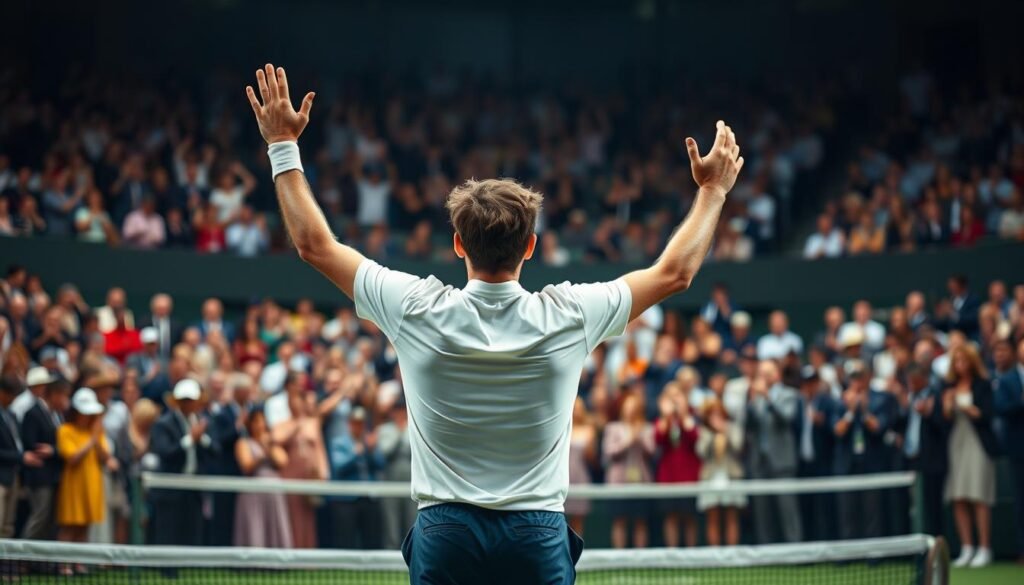
The moniker “The Graceful King” encapsulates more than just Roger Federer’s playing style—it represents his entire approach to tennis and his place within sporting culture. This nickname, which gained prominence during the height of his dominance, carries multiple layers of significance that help explain Federer’s unique position in tennis history and global sports culture.
Evolution from Temperamental Youth to Composed Champion
Perhaps the most remarkable aspect of Federer’s grace was that it wasn’t innate but developed. As a junior player and early in his professional career, Federer was known for emotional outbursts and racquet throwing. His transformation into the composed figure who rarely displayed negative emotions on court represents one of sports’ most impressive personal evolutions.
This journey from temperamental youth to composed champion resonated with fans and fellow athletes alike, demonstrating that emotional control could be cultivated through dedication and self-awareness. It added depth to the “Graceful King” persona, showing that his composure was earned rather than inherited.
“I don’t get the anxiety during a match so much anymore. You know, to throw racquets, to toss balls out of the court, scream and stuff. I almost laugh [on the inside] about it a little bit today when an opponent does it. But that’s something for me that’s not a problem anymore.”
Transcending Tennis Through Cultural Impact
The “King” element of Federer’s nickname reflects not just his dominance but his cultural significance. Unlike many athletes whose influence remains confined to their sport, Federer transcended tennis to become a global cultural icon. His appeal extended to those with little interest in tennis, who were drawn to his elegance, sportsmanship, and ambassadorial presence.
This broader cultural impact was evident in Federer’s unprecedented popularity. He was voted the ATP Fans’ Favorite for 19 consecutive years (2003-2021), won the Laureus World Sportsman of the Year award a record five times, and consistently ranked among the world’s most admired public figures in global surveys.
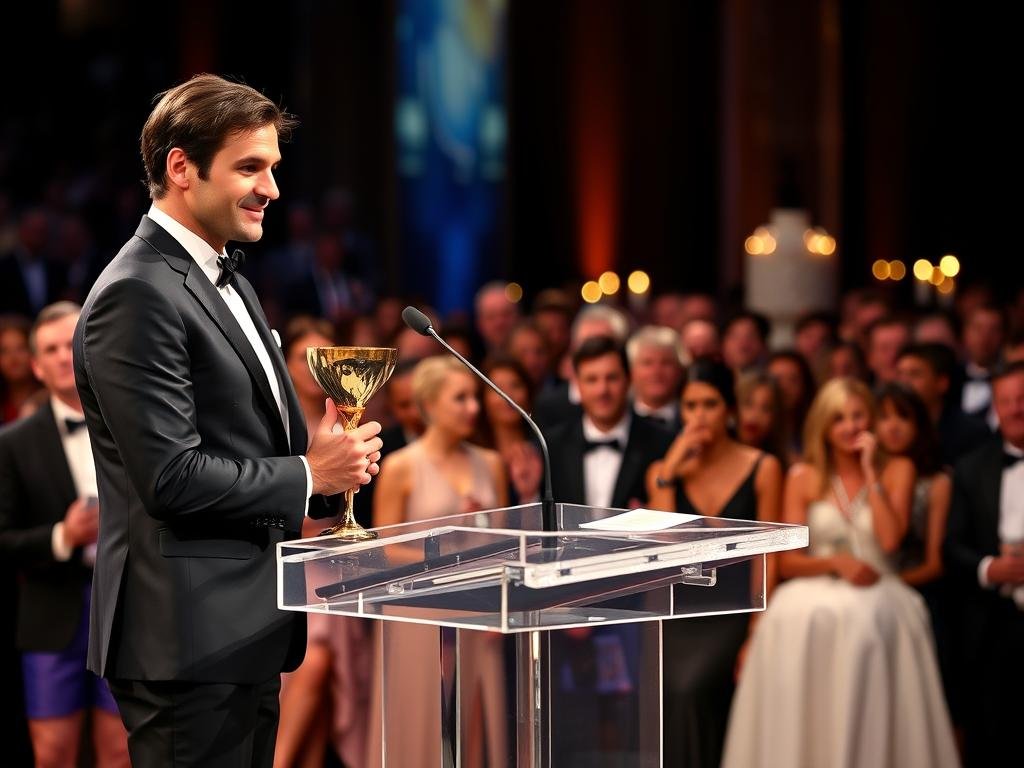
Redefining Athletic Greatness
The “Graceful King” nickname helped redefine the parameters of athletic greatness. In an era increasingly focused on raw power and physical dominance, Federer demonstrated that grace, technique, and artistry remained viable paths to success at the highest level.
This redefinition extended beyond aesthetics to encompass sportsmanship and conduct. Federer won the ATP Sportsmanship Award 13 times, setting a standard for respectful competition that influenced peers and younger players. His gracious behavior in both victory and defeat—particularly following emotionally charged matches against rivals like Rafael Nadal—established a template for how champions could conduct themselves.
Bridging Tennis Eras
As a “King” of tennis, Federer served as a bridge between eras. His career connected the serve-and-volley approach of previous generations with the baseline power game that dominates today. His longevity allowed him to compete against players from Pete Sampras to Carlos Alcaraz, spanning multiple tennis generations.
This bridging function extended to tennis’s global appeal. Federer’s multilingual abilities (he speaks Swiss German, German, English, and French fluently) and cosmopolitan persona helped expand tennis’s reach into new markets and demographics, contributing to the sport’s global growth during his career.
The “Graceful King” nickname ultimately captures the rare combination of competitive excellence and personal dignity that defined Federer’s career. It acknowledges not just what he accomplished but how he accomplished it, recognizing that his manner of playing and conducting himself left as significant a legacy as his statistical achievements.
The Great Rivalries: Defining an Era
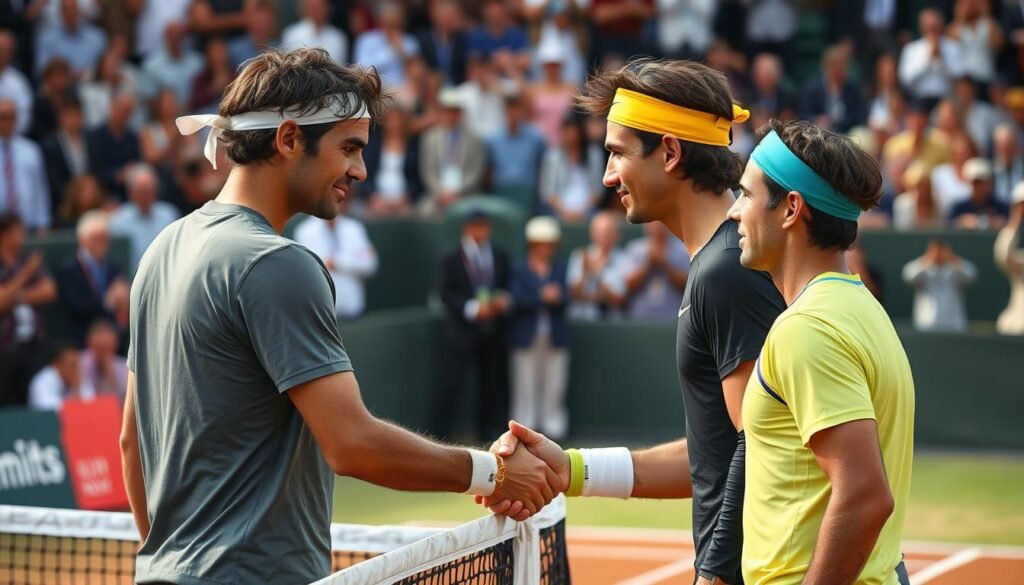
No discussion of Roger Federer’s career would be complete without examining the extraordinary rivalries that defined his era. These competitive relationships—particularly with Rafael Nadal and Novak Djokovic—not only challenged Federer to elevate his game but also produced some of the most memorable matches in tennis history.
Federer vs. Nadal: Fire and Ice
The Federer-Nadal rivalry stands as perhaps the most compelling in tennis history. Their 40 matches (with Nadal leading 24-16) spanned from 2004 to 2019 and featured contrasting styles that perfectly complemented each other: Federer’s fluid, attacking tennis against Nadal’s relentless, spin-heavy game.
Their most iconic battles occurred at Wimbledon, particularly the 2008 final widely regarded as the greatest tennis match ever played. In near-darkness, Nadal prevailed 9-7 in the fifth set after 4 hours and 48 minutes of spellbinding tennis. Equally significant was their 2017 Australian Open final, where Federer, at age 35 and coming back from injury, defeated Nadal in five sets to claim his 18th Grand Slam title.
“I think we pushed each other to become better players. I think we have a lot of respect for each other, on and off the court. I think that’s the most important thing.”
What made this rivalry transcend tennis was the mutual respect between the competitors. Despite the intensity of their matches, Federer and Nadal maintained a warm relationship off court, collaborating on charitable initiatives and expressing genuine admiration for each other’s achievements.
Federer vs. Djokovic: Classical vs. Modern
If Federer-Nadal represented contrasting styles, the Federer-Djokovic rivalry (with Djokovic leading 27-23) embodied the clash between classical and modern tennis. Their 50 matches featured tactical chess matches where Djokovic’s exceptional return of serve and defensive abilities challenged Federer’s attacking instincts.
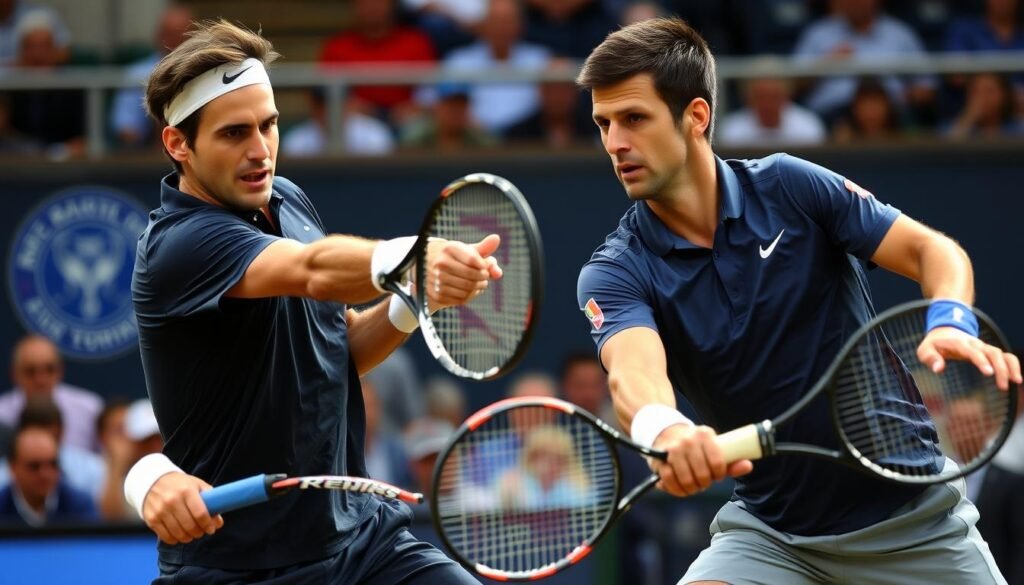
Their most heartbreaking encounter for Federer fans came in the 2019 Wimbledon final, where Federer held two championship points on his serve at 8-7 in the fifth set before Djokovic rallied to win the first-ever Wimbledon final decided by a tiebreak at 12-12 in the final set.
This rivalry was characterized by its psychological dimension. Djokovic, emerging when Federer was already established as a legend, brought a fearlessness that occasionally unsettled the Swiss. Their matches often hinged on crucial points where mental fortitude proved as important as technical skill.
The Big Three Era
Together with Nadal and Djokovic, Federer formed what became known as the “Big Three”—a triumvirate that dominated men’s tennis for nearly two decades. Between 2003 and 2022, they won 63 of 76 Grand Slam tournaments, an unprecedented concentration of success.
| Rivalry | Matches | Federer’s Record | Grand Slam Finals |
| vs. Rafael Nadal | 40 | 16-24 | 10 (Federer won 4) |
| vs. Novak Djokovic | 50 | 23-27 | 5 (Federer won 1) |
| vs. Andy Murray | 25 | 14-11 | 3 (Federer won 3) |
This era of extraordinary competition elevated tennis’s global profile and produced a golden age of technical excellence and compelling narratives. Each member of the Big Three pushed the others to new heights, resulting in an arms race of improvement that benefited the sport as a whole.
Federer’s rivalries demonstrated his adaptability and resilience. Against Nadal, he continually refined his backhand and clay court approach. Against Djokovic, he experimented with more aggressive returning and net play. These adjustments showed his willingness to evolve rather than rest on his laurels.
Perhaps most significantly, these rivalries humanized Federer. His occasional vulnerability against his greatest opponents made his triumphs all the more meaningful and revealed the competitive fire beneath his composed exterior. In facing worthy adversaries, the Graceful King showed that true greatness is forged through challenge rather than dominance alone.
Legacy Beyond Tennis: The Global Impact of Roger Federer
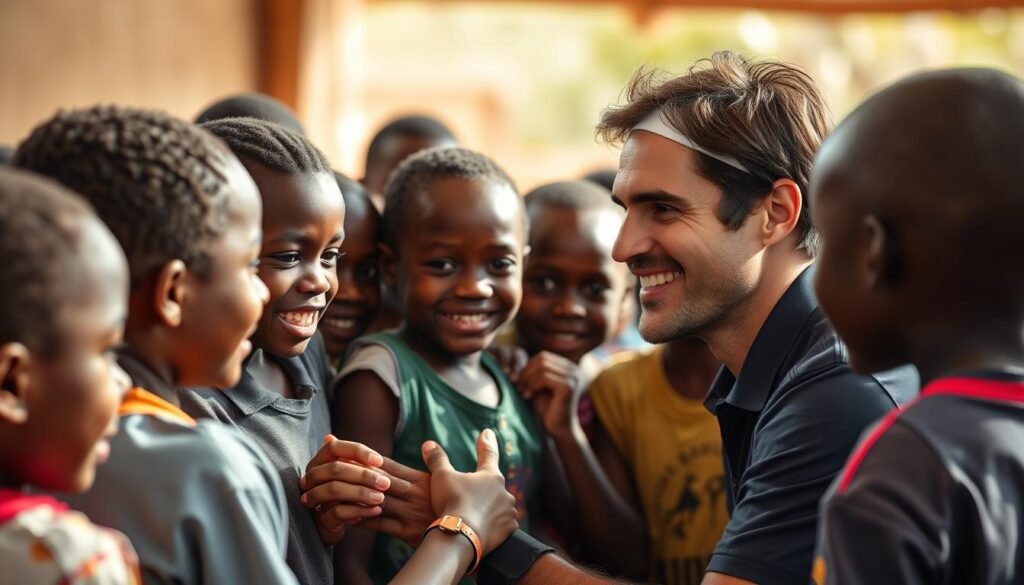
While Roger Federer’s on-court achievements secured his place in tennis history, his influence extends far beyond the baseline. His impact on philanthropy, business, and global culture has created a legacy that will endure long after his playing days.
Philanthropic Vision
In 2003, at just 22 years old and before winning his first Grand Slam, Federer established the Roger Federer Foundation. This early commitment to giving back demonstrated a maturity and perspective rare in young athletes. The foundation focuses primarily on educational initiatives in southern Africa and Switzerland, with a particular emphasis on early childhood education.
The foundation’s approach reflects Federer’s methodical nature, emphasizing sustainable, locally-driven programs rather than short-term interventions. By 2023, the foundation had invested over $70 million in educational programs, benefiting more than 2 million children across seven African countries and Switzerland.
“I believe in the power of people. We know that a good education empowers children by allowing them to take their future into their own hands and play an active part in shaping it.”
Federer’s philanthropic efforts extend beyond his foundation. His exhibition series “Match for Africa” has raised millions for educational initiatives, often featuring matches against his greatest rivals. During the COVID-19 pandemic, he and his wife Mirka donated 1 million Swiss francs to vulnerable families in Switzerland, demonstrating their commitment to their home country.
Business Acumen and Brand Building
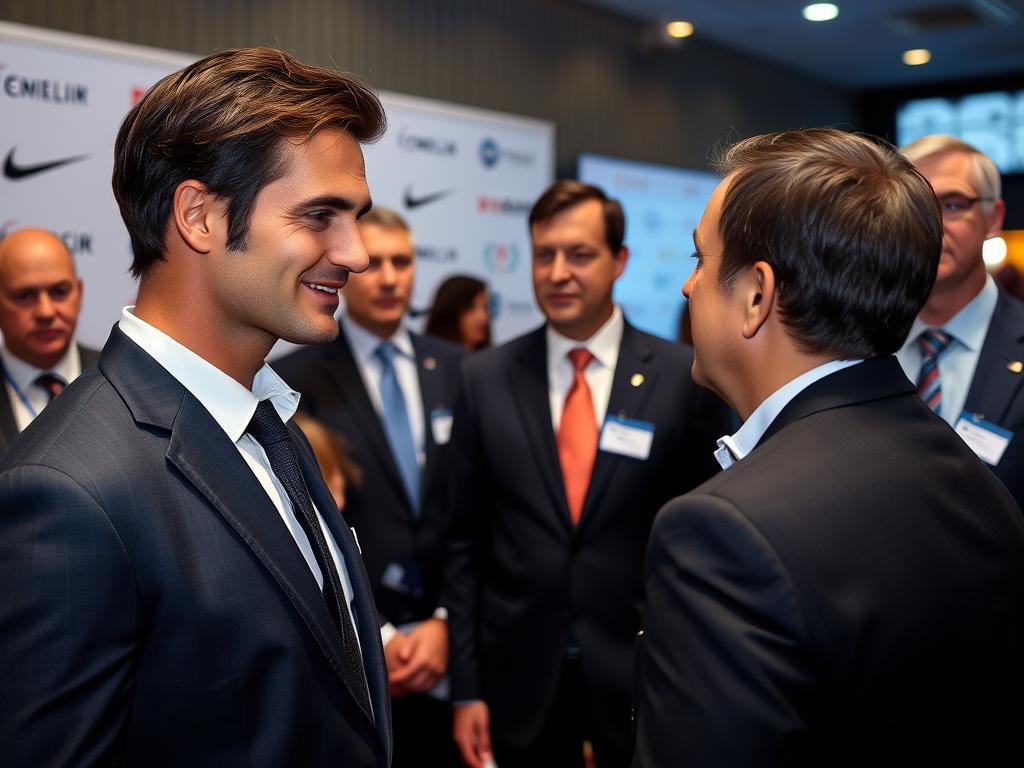
Federer’s approach to his career off the court has been as strategic as his on-court tactics. He pioneered a new model for athlete endorsements, focusing on long-term partnerships with premium brands that aligned with his image. This selective approach—working with companies like Rolex, Mercedes-Benz, and Credit Suisse—created a portfolio of partnerships that emphasized quality over quantity.
His business acumen was particularly evident in his 2018 decision to leave Nike after 24 years for a $300 million deal with Uniqlo. This move, which allowed him to retain ownership of his “RF” logo, demonstrated his understanding of personal brand value. Similarly, his investment in Swiss shoe company On, where he holds a 3% stake worth hundreds of millions, showed foresight in moving from endorser to equity partner.
These business decisions have made Federer tennis’s highest earner despite not always topping the prize money rankings. In 2020, he became the first tennis player to top Forbes’ list of highest-paid athletes, with earnings of $106.3 million. By 2023, his net worth had reportedly reached $1.3 billion, making him one of the few athletes to achieve billionaire status.
Cultural Ambassador
Perhaps Federer’s most significant legacy lies in his role as a cultural ambassador—not just for tennis or Switzerland, but for a certain approach to sport and life. His multilingual abilities (he speaks Swiss German, German, English, and French fluently) and cosmopolitan outlook have made him an effective bridge between cultures.
In an era of increasing polarization, Federer has maintained universal appeal. He has been voted the ATP Fans’ Favorite for 19 consecutive years, an unprecedented streak that spans generations of tennis fans. This popularity transcends national boundaries, with Federer enjoying passionate fan bases from China to South America.
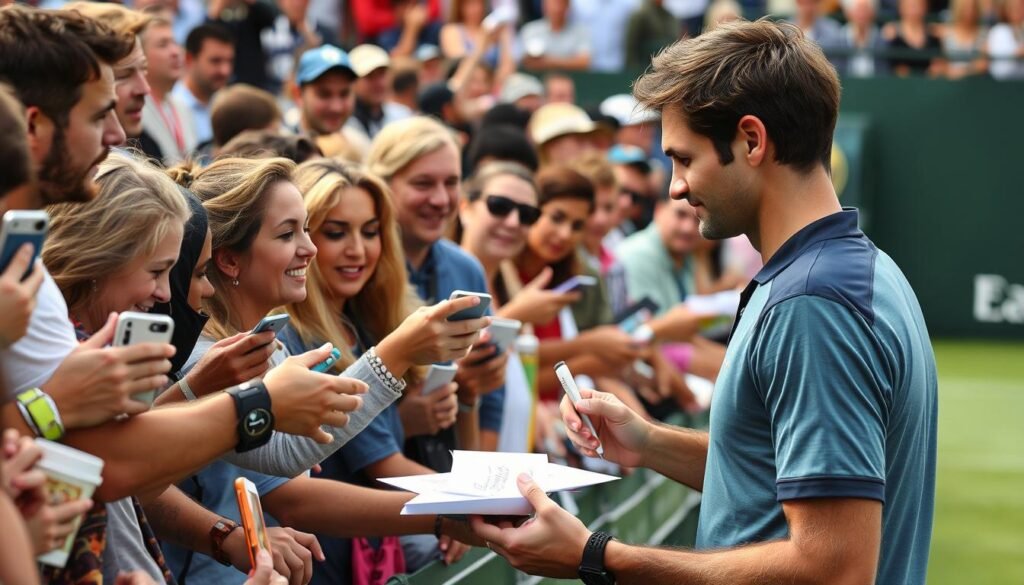
His influence on tennis itself has been transformative. The Laver Cup, which Federer helped create in 2017, introduced a new team format that has energized the sport. His playing style inspired a generation of one-handed backhand players despite the trend toward two-handed backhands. And his emphasis on sportsmanship has elevated the standard of conduct throughout professional tennis.
Beyond sports, Federer has become a symbol of Swiss precision and excellence. In 2019, he became the first living person to be honored on Swiss currency, with commemorative coins bearing his image. Switzerland’s tourism board appointed him as an ambassador, featuring him in campaigns that playfully highlight the country’s attractions.
“In tennis, we share a tiny locker room for 15 years. We’re supposed to have clothes on but, you know, it’s awkward at times. You can’t be best friends. But on the road, I think we get along really well.”
As Federer transitions into post-playing life, his legacy continues to evolve. His farewell at the 2022 Laver Cup, where he partnered with longtime rival Rafael Nadal in his final match, provided a fitting conclusion to his playing career—emotional, graceful, and centered on the relationships that defined his journey.
Through his foundation, business ventures, and cultural impact, Roger Federer has created a blueprint for how athletes can leverage their platform for positive change. The Graceful King’s reign on court may have ended, but his influence continues to shape tennis and global culture in profound and lasting ways.
Grace Under Pressure: The Mental Fortitude of a Champion
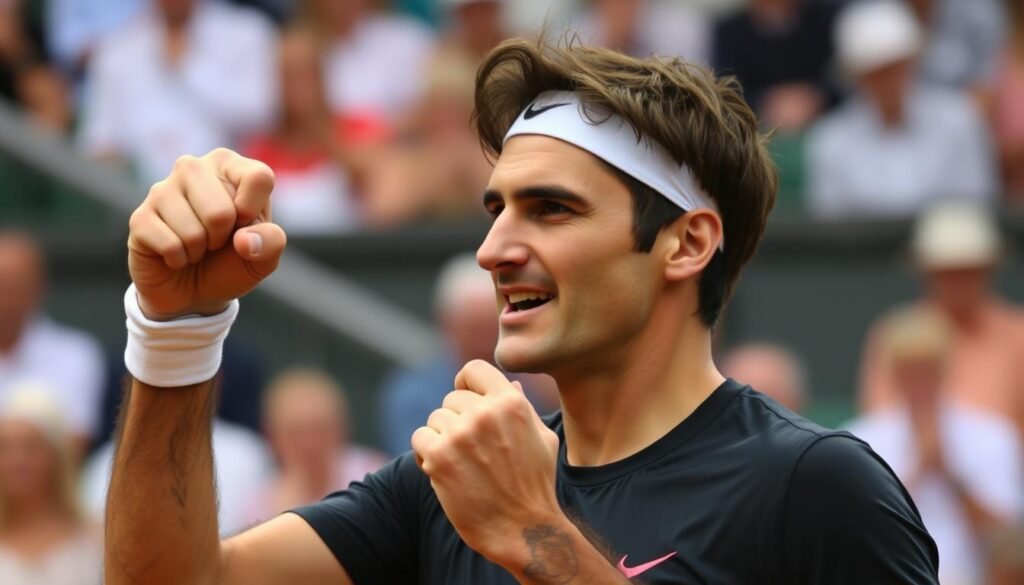
Beyond his technical brilliance and physical gifts, Roger Federer’s mental approach to tennis set him apart from his contemporaries. His ability to maintain composure under extreme pressure earned him the reputation as one of the sport’s greatest psychological performers.
The Art of Emotional Control
What made Federer’s emotional control remarkable was that it wasn’t innate but developed. As a junior player, he struggled with outbursts and racquet throwing. His transformation into the composed figure who rarely displayed negative emotions on court represents one of sports’ most impressive personal evolutions.
This journey from temperamental youth to composed champion added depth to the “Graceful King” persona, showing that his composure was earned rather than inherited. It also provided an inspiring example of how emotional intelligence could be cultivated through dedication and self-awareness.
“I had to learn how to handle the pressure of being the favorite in a tennis match. It’s incredibly difficult. The most important victory of all is the one that happens internally.”
Voices from the Tennis World
Those who competed against, coached, or observed Federer consistently noted his exceptional mental approach to the game. Their perspectives provide valuable insight into how his psychological fortitude complemented his physical skills.
“His greatest quality is that he doesn’t have many weaknesses. Even if he’s not playing his best tennis, he finds a way to win. That’s the sign of a true champion.”
“What’s made him great is that he’s been able to win so many ways on different surfaces. His mind is so strong. He has this ability to forget bad losses quickly and move on.”
“In an era of specialists, you’re either a clay court specialist, a grass court specialist, or a hard court specialist… or you’re Roger Federer.”
“Roger’s got the most complete game of his generation, and maybe the most complete game ever. But it’s his mind that puts him apart. His mental approach is just phenomenal.”
Defining Moments of Mental Strength
Throughout his career, certain matches highlighted Federer’s exceptional mental fortitude. The 2017 Australian Open final against Rafael Nadal stands as perhaps the most compelling example. Coming back from injury at age 35, Federer found himself down a break in the fifth set against his greatest rival—a player who had repeatedly bested him in Grand Slam finals.
Rather than succumbing to the weight of history, Federer produced some of his most aggressive and fearless tennis, winning the final five games to claim his 18th Grand Slam title. This victory, which many considered impossible given the circumstances, demonstrated his ability to embrace pressure rather than avoid it.
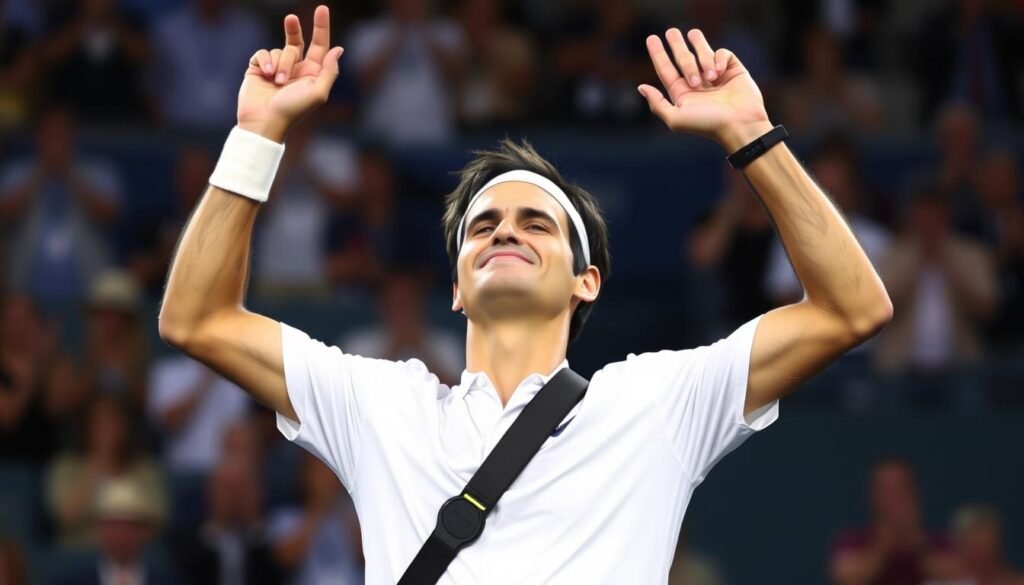
Similarly, his 2009 French Open victory showcased his resilience. After three consecutive finals losses to Nadal at Roland Garros, Federer finally captured the elusive title, completing his Career Grand Slam. The relief and joy he displayed afterward revealed how much mental energy he had invested in this pursuit.
Even in defeat, Federer’s mental approach stood out. Following his heartbreaking loss to Djokovic in the 2019 Wimbledon final—where he held two championship points—Federer displayed remarkable perspective in his post-match comments, focusing on the positives rather than dwelling on the narrow margin between victory and defeat.
The Psychology of Longevity
Federer’s mental approach contributed significantly to his unprecedented longevity at the top level. His ability to process losses constructively, maintain motivation through different career phases, and adapt his game to changing physical capabilities all stemmed from his psychological resilience.
Unlike many athletes who struggle with the inevitable decline that comes with age, Federer embraced the challenge of reinvention. After a difficult 2013 season, he adjusted his racquet size, modified his backhand technique, and rethought his scheduling—changes that required both humility and confidence.
“There’s always a lot of pressure coming into Wimbledon. I’m just happy that I was able to deal with it. It’s not easy, especially when you’re the defending champion.”
His decision to undergo knee surgery and take six months away from the tour in 2016—a risky move at age 35—demonstrated his willingness to make difficult choices with long-term benefits in mind. The spectacular results that followed in 2017 vindicated this patient, strategic approach.
Perhaps most impressively, Federer maintained his love for tennis throughout his long career. Where many athletes begin to view their sport as a job or burden after years of competition, Federer consistently expressed genuine enthusiasm for practice, competition, and improvement—a mindset that kept him mentally fresh despite the physical demands of the tour.
This combination of emotional control, competitive resilience, strategic thinking, and enduring passion created the mental foundation upon which Federer’s technical brilliance could flourish. The Graceful King’s reign was as much a triumph of mind as of body, demonstrating that true greatness in sport requires psychological mastery alongside physical excellence.
A Graceful Exit: Federer’s Farewell to Tennis
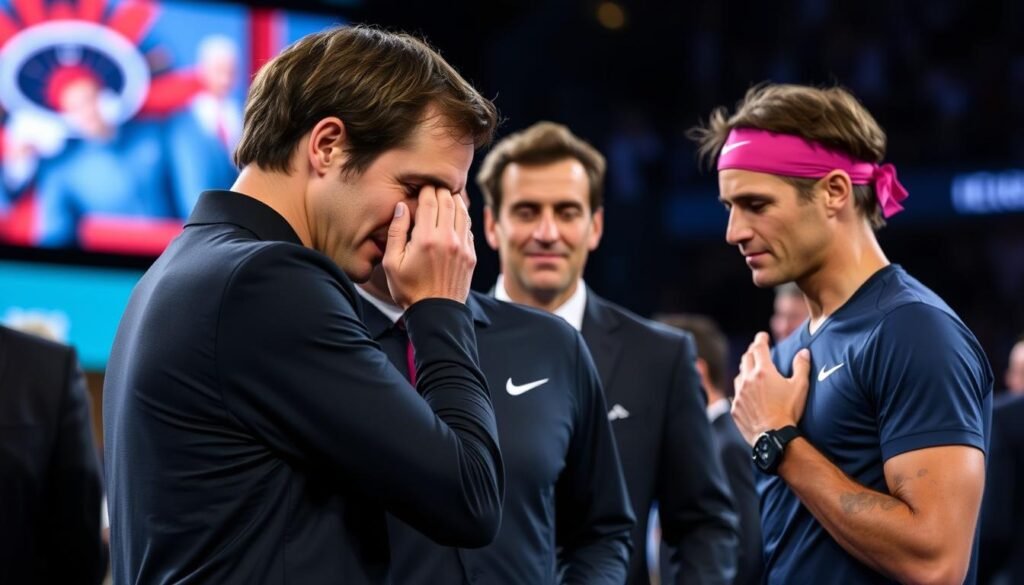
After 24 years as a professional, 20 Grand Slam titles, and countless memorable moments, Roger Federer bid farewell to competitive tennis in September 2022. True to his character, his exit from the sport he had defined for so long was executed with the same grace that characterized his playing career.
Federer announced his retirement through a thoughtful letter to fans, acknowledging that his body had sent him “clear messages” following three knee surgeries and the challenges of returning to top form at age 41. Rather than pursuing additional comebacks, he chose to conclude his career on his own terms at the Laver Cup—the team competition he had helped create.
“To the game of tennis: I love you and will never leave you.”
The setting proved perfect for Federer’s farewell. Surrounded by his greatest rivals—who had become friends and collaborators—he partnered with Rafael Nadal in doubles for his final match. Though they lost in a tight contest, the result seemed almost incidental to the emotional significance of the moment.
What followed became one of tennis’s most poignant scenes: Federer and Nadal sitting side by side, hands clasped, tears flowing freely as Ellie Goulding performed during the ceremony. This unguarded display of emotion from two fierce competitors captured the deep bonds formed through their rivalry and mutual respect.
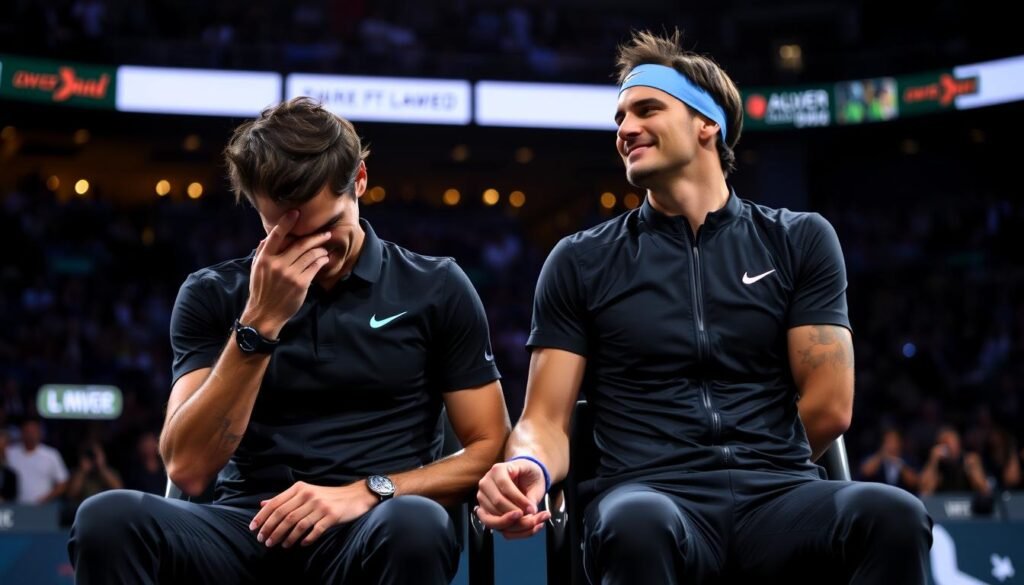
The tributes that poured in following Federer’s announcement reflected his impact beyond statistics. From fellow athletes to world leaders, artists to everyday fans, the messages shared a common theme: appreciation not just for what Federer had accomplished but for how he had conducted himself throughout his career.
“What a career, what a champion, what a legend. Congratulations on an incredible career Roger Federer. We will miss seeing you grace the courts, but thank you for all the memories!”
“Roger Federer is a champion’s champion. He has the most complete game of his generation & captured the hearts of sports fans around the world with an amazing quickness on the court & a powerful tennis mind.”
In his post-retirement life, Federer has maintained his connection to tennis while exploring new avenues. He has appeared at major tournaments as a spectator, participated in exhibition events, and continued his work with the Laver Cup. His foundation remains active, and he has expanded his business portfolio, including his investment in the Swiss shoe company On.
Perhaps most significantly, Federer has embraced his role as an elder statesman of tennis, offering perspective and support to the next generation of players. His willingness to step away from the spotlight while remaining engaged with the sport demonstrates the same balance and wisdom that defined his playing career.
Federer’s graceful exit provides a fitting final chapter to his tennis story. In choosing the right moment to step away, acknowledging his limitations while celebrating his achievements, and expressing genuine gratitude to those who supported his journey, he offered one last masterclass in how to conduct oneself with dignity and perspective.
The Graceful King may have abdicated his throne, but his influence on tennis—and on how champions can carry themselves—continues to shape the sport he loved and the culture surrounding it.
The Enduring Legacy of The Graceful King
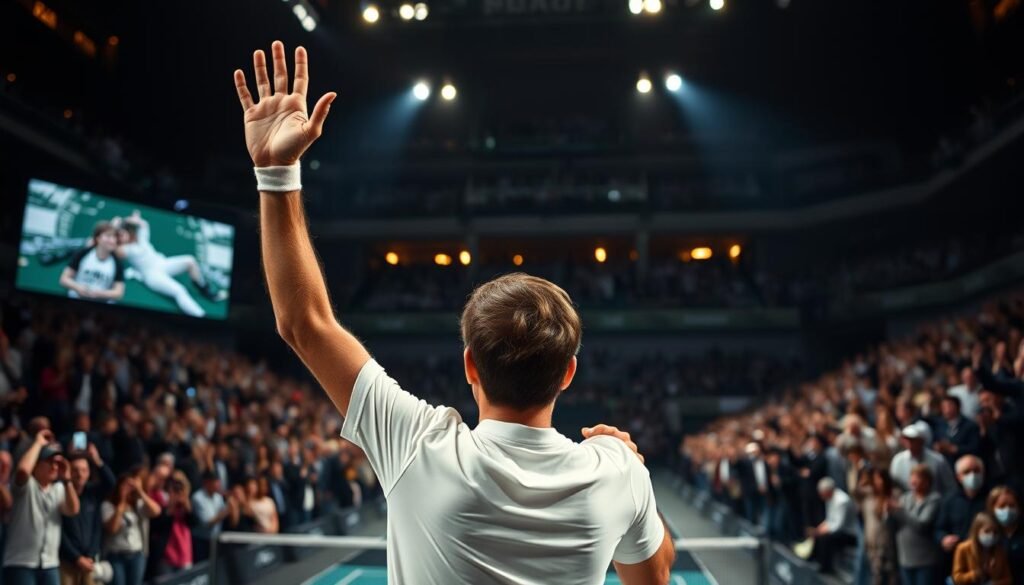
As we reflect on Roger Federer’s remarkable journey from temperamental junior player to global icon, what emerges is not just the portrait of a tennis champion but of someone who redefined what athletic greatness could encompass. His legacy extends far beyond his 20 Grand Slam titles or 310 weeks at world number one—impressive as those achievements are.
Federer showed that excellence need not come at the expense of sportsmanship, that competitiveness could coexist with respect, and that athletic performance could approach artistic expression. In an era increasingly defined by power and physicality, he demonstrated the enduring value of technique, timing, and tactical intelligence.
His influence on tennis will be felt for generations. Young players now grow up studying his footwork, his shot selection, and his ability to construct points. Coaches reference his matches when teaching the fundamentals of the game. Tournament directors credit him with helping expand tennis’s global appeal and commercial success.
“When you do something best in life, you don’t really want to give that up – and for me it’s tennis. It started as a childhood dream which turned into a reality. I had a wonderful time on the tour and I’ll miss the competition.”
Beyond the court, Federer’s approach to his career and public life offers a template for athletes in all sports. His strategic business decisions, commitment to philanthropy, and careful management of his personal brand have created a blueprint for how modern athletes can leverage their platform for both financial success and positive social impact.
Perhaps most importantly, Federer’s career reminds us that sports at their best can inspire, unite, and elevate. The moments of breathtaking skill he produced, the rivalries he helped forge, and the grace with which he competed created experiences that transcended tennis to become cultural touchstones.
The nickname “The Graceful King” captures the essence of Federer’s contribution to tennis and to sports culture more broadly. It acknowledges both his competitive achievements and the manner in which he achieved them—with a dignity, artistry, and humanity that made him not just a champion but a global ambassador for the values of excellence and respect.
As tennis moves forward into its post-Federer era, his influence remains omnipresent. In the one-handed backhands of the next generation, in the emphasis on sportsmanship at all levels of the game, and in the memories of those fortunate enough to have witnessed his career, The Graceful King’s legacy endures—a testament to a player who didn’t just master tennis but transformed it.
Support Roger Federer’s Vision for Education
The Roger Federer Foundation has impacted over 2 million children through educational initiatives in southern Africa and Switzerland. Join Roger in his mission to empower children through quality education and create lasting change.
Explore More About Roger Federer
Federer’s Greatest Matches
Relive the most spectacular moments from Roger Federer’s illustrious career, from his breakthrough win against Pete Sampras to his final Grand Slam triumph.
The Evolution of Wimbledon
Discover how Roger Federer’s eight championships helped shape the modern era of Wimbledon and cemented the tournament’s place in tennis history.
Tennis’s Golden Era
Explore how the rivalries between Federer, Nadal, and Djokovic created what many consider the greatest era in men’s tennis history.

